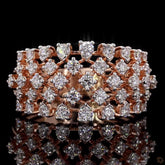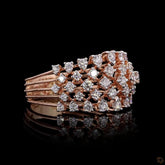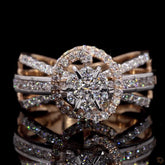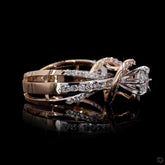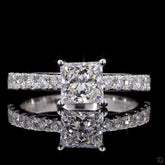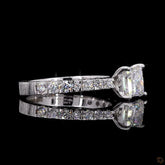What are Lab Grown Diamond?
Tell me more about these lab grown diamond beauties
Lab-grown diamonds are like the cool, eco-friendly siblings of traditional bling! They're sparkly gems that scientists create in a high-tech lab instead of Mother Nature's underground jewelry factory. These diamonds are made by putting a seed crystal in a lab oven, giving it a super-duper hug of carbon, and letting it grow into a dazzling crystal, just like magic (but with a touch of science). So, you get all the glitz and glam without the guilt, and you can proudly say you're rocking diamonds that are as hip as they are sparkly!
A diamond shopping guide (From a diamond lover, to a diamond lover)
Diamond cuts are like the fashion trends of the gem world. You've got the classics, like the Round Cut, which is like the little black dress of diamonds - always in style and goes with everything.
Then there's the Princess Cut, sharp and edgy, fit for a modern-day royal. The Emerald Cut, long and elegant, is like the red carpet of diamonds - it's all about the drama, darling.
The Marquise Cut is a bit of a diva, with its long and pointed shape, perfect for showing off. And the Heart Cut, well, that's just the diamond version of a love letter - sweet, sentimental, and ready to steal your heart.
But if you're feeling bold, go for the Asscher Cut - it's like the diamond's way of saying, "I'm different, and I'm proud of it!" So, pick your cut and rock your bling with style and personality!
Moissanite Vs. Diamond Vs. Lab Grown Diamond
1. Origin
- Moissanite is a naturally occurring mineral, but most on the market are lab-grown.
- Real diamonds are natural gems formed deep within the Earth.
- Lab-grown diamonds are created in a controlled environment, replicating the natural diamond-growing process.
2. Hardness
- Real diamonds are the hardest natural substance, ranking 10 on the Mohs scale.
- Moissanite is nearly as hard as diamonds, ranking at 9.25.
- Lab-grown diamonds also have a high hardness, matching natural diamonds.
3. Brilliance
- Moissanite often exhibits more fire (colorful flashes) than real diamonds.
- Real diamonds have exceptional brilliance and sparkle.
- Lab-grown diamonds closely mimic the brilliance of natural diamonds.
4. Cost
- Moissanite is generally more affordable than both real and lab-grown diamonds.
- Real diamonds are typically the most expensive option.
- Lab-grown diamonds are more budget-friendly than natural diamonds but can still be costly.
5. Color
- Moissanite can have a slight yellow or green tint.
- Real diamonds come in various colors, including colorless and fancy colors.
- Lab-grown diamonds can also vary in color but can be produced as colorless or with specific colors.
6. Origin Disclosure
- Moissanite is not a diamond and should be disclosed as such.
- Real diamonds are naturally occurring and need no disclosure.
- Lab-grown diamonds should be disclosed as such to distinguish them from natural diamonds.
7. Environmental Impact
- Moissanite has a relatively low environmental impact, especially when lab-grown.
- Real diamond mining can have significant environmental and social impacts.
- Lab-grown diamonds are considered more environmentally friendly due to reduced mining.
8. Inclusions
- Moissanite is less likely to have inclusions (internal flaws) compared to real diamonds.
- Real diamonds can have various types of inclusions.
- Lab-grown diamonds can also contain inclusions, depending on the quality.
9. Popularity
- Moissanite is gaining popularity as an affordable diamond alternative.
- Real diamonds have been a symbol of luxury and love for centuries.
- Lab-grown diamonds are becoming increasingly popular due to their ethical and
- environmental advantages.
- Choosing a selection results in a full page refresh.
